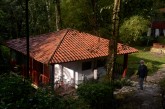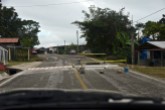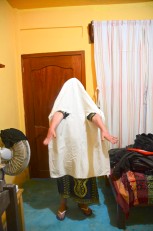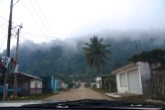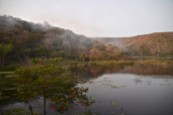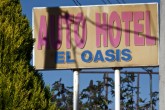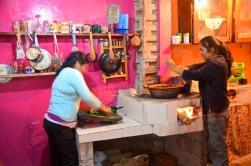I’ve taken a bit of a hiatus from writing – as in over two years! — having way too much fun enjoying life and taking no time to write about it.
However, we recently completed a two-week sojourn between Puerto Morelos at the southeastern tip of Mexico back home to Guanajuato in the center of the country. Our normal quick-trip version is only 2500 kilometers which we normally drive in two long days. But with side trips, getting lost, sight-seeing, enjoying special times with dear friends, and just appreciating The Mexico Experience, this trip racked up over 4000 kilometers – nearly 2,500 miles.
Motivation for our unforgettable journey was a visit by Peter’s sister and brother-in-law from the United Kingdom: Fiona and Chick Hutchings. We wanted these English world-travelers to experience the “real” Mexico – beaches, mountains, pueblos, street food, tuk-tuks, police and military stops (all exceptionally polite), topes, and more….
We tend to travel – not exactly cheap, but reasonably – opting to stay in smaller towns rather than in the more expensive heart of cities or the classic beach resorts. This also allows for a more “Mexico” and less “touristy” experience.
Thus, we leave the relative luxury of our Puerto Morelos beachside condominium to head toward Palenque in the state of Chiapas.
Quintana Roo’s highways are the dullest part of the journey. Although QRoo has incredible white-sand beaches with seven-shades-of blue Caribbean sea, the only view from the roads is a flat, green corridor of tall jungle and scrubby brush, broken up by the occasional pueblo and dog-in-the-street.
Just before dusk, we found a delightful basic hotel, surprisingly, in the industrial edge of Ciudad Campache: Hotel Bambu with spacious rooms, king-size bed, decent mattress, hot water with great pressure, and a reassuring view of the secure (if not exotic) parking lot. Attached was an excellent family-run restaurant with an hospitable staff who kindly prepared special dishes just for us — and since they only served soft drinks, we brought our own beer and wine (with no corkage fee). At 550 pesos (about$30)/night — this set the bar high for our nightly stays!
We always travel with our own electric hot plate, espresso pot, and favorite coffee blend from Veracruz, because, with a few notable exceptions, Mexican coffee is usually instant Nescafe, thick mud, or merely colored water. So with steaming mug in hand, we head out early the next morning. More green corridor interspersed with palm trees, the golden-sand beaches of the Gulf of Mexico, and the ever-present “Mexican Airforce” (pelicans) — finally arriving at Palenque just before dark.
At the suggestion of friends, we thought we’d check out accommodations at nearby Misol-Ha Cascades (waterfalls). Being Saturday night, we were a bit concerned that all their 14 cabañas might be full, but !Hey! – Let’s go for it! After paying 10 pesos/person at the Ejido’s (local indigenous people’s) rope-over-the-road entry, darkness officially descended. The only ambient light was from the restaurant/registration area, but our greeter had a flashlight to show us available cabins in the surrounding jungle.
Although there were “family cabins” with multiple bedrooms and a kitchenette, we opted for a duplex directly beside the waterfalls – which, at this time of night, we could hear but not see. Despite being a weekend, much to our surprise, only one other cabin was occupied. We were virtually alone in the forest and slept to the “white noise” of cascading water – and awoke to a cacophony of birdsong.
Following two nights in jungle-forest paradise at only 250 pesos (about $13 US dollars)/night and many delightful meals and cocktails in the restaurant (at exceptionally reasonable prices), we traveled onward, across Chiapas. So far, we’d been incredibly fortunate in finding comfortable accommodations at a great value.
That changed.
We’d planned to visit San Cristobal de Las Casas high in the mountains, but our friend Robert had driven that route the previous week and strongly advised against it – ranting about disgruntled local men stopping him and other tourists to extort money – threatening to scatter nails under the tires if they didn’t pay.
With this warning in mind, I asked a local tour-van driver about the situation. After a poignant pause, he replied, “Perhaps they’re not doing this any more.” He suggested we drive about five hours on up toward San Cristobal and ask someone in Ocosingo if it would be safe to go on. If not advisable, there was a secondary road we could take through the mountains to go the rest of the way.
That option did not sound appealing.
Thus, we took the “The Loop” on the other side of the mountains along the border of Guatemala. ?Porque no? Why not? New territory for us. Always up for An Adventure.
So – off we drive – up and up and up into mountains of green, towering forest — and topes!!
Topes— Speed Bumps – Vibradores – Reductors – Ropes — Muffin Tops – Slow-you-down humps in the road — or just rocks. Many, followed by pot-holes and road drop-offs.
An un-imaginable number of these speed bumps – from gentle slopes to abrupt “walls” designed to slow and damage the vehicle if not “respected.” Every curve. Every village. Every hovel. A speed bump (or several) for each. In more than six hours, we traveled only 350 kilometers (about 200 miles). Thus, we did not reach our hoped-for destination before dark.
The map indicated only villages. Tobias, our GPS, showed a strip of hotels in an upcoming wide-spot-in-the-curvey-mountain road called Maravilla. We know better than to trust Points of Interest on Tobias, but driving these roads at night was not an option. So we followed his directions. Not a hotel in sight, and certainly not a string of them. Open and well-lit, however, was a 24-hour funeral parlor where we asked about hotels. One. Around the corner. We’d already passed its drooping sign three times without realizing it was a hotel. Its name: Los Esperamos (We Wait for You).
I examine a room (Do we have a choice?). Two rooms are available (In reality: This dump is deserted). Less than basic, with no hot water, no heat, moldy walls, bare bulbs, a vine twisting out of the rusty air conditioner. But the sheets look clean. And. They’ll provide an extra blanket. Four hundred pesos. My inside voice says, “Are you f*#ing kidding me?” To the proprietor, I say, “!Muy caro! Very expensive!” Well ok, she tells me, 300 pesos. Still horribly overpriced at $16 US dollars, but we need it. Any port in a storm, so to speak.
As we enjoy a nightcap glass of wine –and Chick, his cigar — on the patio beside the motorcycles and towel-covered parrot cage, scruffy resident dogs wander in-and-out of our rooms. One curls up on Fiona’s bed. As we settle in for the night, Peter and I close the windows, put on the extra blanket, and snuggle down in the Mexico “matrimonial” bed, only slightly wider than a USA “single.”
At the risk of Too Much Information, Chick informed us that his evening’s entertainment while sitting on the commode was watching a cockroach ramble along the wall, eventually scampering into the sink (which had no faucets) and into Fiona’s panties, which she planned to wash the next morning during her cold shower. Being a fellow who won’t kill any living thing (except, perhaps mosquitoes), he allowed the intruder to stay warm and snug for Fiona to discover and deal with in the morning.
Next morning – mist and crisp mountain air. With no hot water, a shower is out of the question. So, perhaps a brisk wash in the sink – but –unlike Fiona and Chick’s, our sink has faucets but the pipe is disconnected. The towels, we discover, are riddled with holes – significantly large ones.
Peter makes coffee using our carry-everywhere electric hot-plate (not bad for heating the room, either), and we take a steaming mug to our neighbors. Fiona has disposed of the cockroach and is preparing for the day. Chick, cocooned in thin blankets, shivers in the bed, having spent a miserably cold night. We glance around — “Hey, Chaps – why don’t you close the windows?”
A pleasure to leave Maravilla – through drop-dead beautiful scenery and the least-maintained, most dangerous roads of the trip which could literally cause “drop-dead.”
Next stop, Esquintla, Chiapas. Hotel St. Jorge. We opted for adjoining “junior suites” at 540 pesos (about $30 US) for two nights – a welcome break from the constant driving through topes and rough roads. Pure luxury. Vaulted ceilings painted with clouds and cherubs, shared walls with open glass at the top so you could hear the proverbial pin drop next door – and a balcony! Ideal for evening cocktails to watch the streets roll up at dusk and for morning coffee to hear the city come to vibrant life at daybreak.
Just for grins, we take a tuk-tuk tour of the town. We made that driver’s day – 250 pesos (about $13) for the four-hour tour of the village – gigantic 400-year-old cieba trees, cultural center, neighborhoods, lunch, and later, “the best tacos town.” He drove by the next day to warmly bid us good-bye.
On to Barra de Santa Cruz, Oaxaca. Our most relaxing experience of the journey – a lakeside hideaway owned by our friend Mac MacEachern. Five nights of tranquil lake living just a few kilometers from Huatulco’s golden beaches flanked by mountains, breakfast lovingly prepared by Estella the housekeeper, dinners at Las Gemelas restaurant with toes-in-the-sand, serene nature, hammocks, visits with Mac, and time for Peter to play guitar.
We were privileged to experience a visiting osprey hunting for her breakfast over the lake.
Next stop for another novel experience, a “motor hotel”– a No-Tell Motel which rents by the hour as well as by the night. We select these whenever we can because – for ultimate privacy and security — each room has its own garage. Many also have “dumb waiters” – Call in your order for tacos or sex toys delivered discretely to your room. El Oasis near Mitla, Oaxaca, was not quite that sophisticated, but it did offer a mirrored bed, interesting television channels, and a “special” chair (which, imagination going wild concerning the previous occupants, we decided not to sit upon), and two complimentary bottles of water or soft drinks because we purchased “toda la noche” (all night).
On to Puebla, a UNESCO World Heritage Site founded by the Spanish in 1531. This colorful city has more than 70 churches in the historic center alone and over 1000 colonial-era buildings adorned with its famous Talavera ceramic tiles. Architectural styles range from Renaissance to Mexican Baroque.
We splurge for a hotel near the zocolo (main square) for an “executive suite” with a bathtub for the exorbitant price of 876 pesos. We’re hmmm-ing and haw-ing over the price until we realize that’s only about $45 US dollars.
From there, through Zitacuaro, Michoacán, and across the state line to the tiny village of Mancheros, Mexico, to stay at JM Butterfly BnB. The migration of the monarchs and being surrounded by hundreds of thousands of them on the reserve of Cerro Pelon is another topic, but the BnB itself, with its tranquil setting at 8,500 feet above sea level, expansive vistas, delightful people, and amazing home-cooked local cuisine is well worth the trip.
We stay three nights, enjoying the company of hosts Ellen and Joel, guests from around the world, homey atmosphere, mountain hikes, a horseback ride up to 10,000 feet into Cerro Pelon Butterfly Preserve, and a Mexican cooking class.
Thus, at the conclusion of two weeks and 4000 kilometers on the road, our visitors from the United Kingdom arrived at our home in Guanajuato – a cultural city like no other – having experienced a cross-section of the “real” Mexico, with hotels and accommodations as diverse as its cities, its countryside, and its delightful highly hospitable people.
About the Accommodations
Condominium Las Iguanas, Puerto Morelos. I rent my condo through VRBO/660904 for $225 USD/night. One-half block from the white-sand beach, ten-minute stroll into town.
Hotel Bambu. Campache. 550 pesos/night (about $30 USD). Family-run. In-hotel restaurant with friendly hosts. No alcohol, but we brought our own wine and beer. A comfortable, welcoming place to stay when you’re on your way to elsewhere.
Misol-Hal Cascades near Palenque, Chiapas. 250 pesos/night (about $13 USD). Excellent restaurant/bar that was open as long as we wanted to stay. When they ran out of red wine, we brought our own. Internet in the restaurant. We’ll definitely return.
Hotel Los Esperamos. Maravilla, Chiapas. 300 pesos (about $16 USD). Don’t bother.
Hotel St. Jorge. Esquintly, Chiapas. Jr. Suite. 540 pesos (about $30 USD). In-room internet. Basic room with “matrimonial” bed 500 pesos. For 40 pesos more: king bed, vaulted ceilings painted with clouds and cherubs, balcony. It has hot water, but not necessarily today.
El Oasis. Motor hotel (no-tell motel). Mitla, Oaxaca. 300 pesos (all night, $15 USD). Comfortable and secure. Mirrored ceiling, “special activity” chair, private parking garage, king bed with mirror.
Hotel Gilfer. Puebla. One block from main square of the historic district. 876 pesos (about $46 USD). Executive suite with shower and tub and lots of hot water. Internet in the lobby and restaurant.
JM Butterfly BnB. Mancheros, Mexico (nearest large town: Zitacuaro, Michoacán). 1250 pesos (about $66 USD). Beautifully decorated theme rooms, local art, comfortable mattress, luxurious bedding and towels, hot water, lots of natural light, spectacular views. Full breakfast included. Internet in the living room. Tours of Cerro Pelon Butterfly Preserve, cooking classes, hiking, horseback rides, other activities. Uniquely memorable. We have stayed here before and will return again and again.
The Route

Highlighted road is the total journey — starting at the far-southeastern tip of Quintana Roo, 4000 km with us to the middle of Mexico. Fiona and Chick then traveled over 4000 more km via bus to visit more family in Sonora in the north….
























